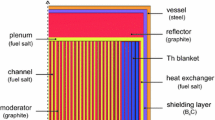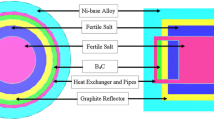Abstract
Present designs for molten salt thermal reactors require complex online processing systems, which are technologically challenging, while an accelerator-driven subcritical molten salt system can operate without an online processing system, simplifying the design. Previous designs of accelerator-driven subcritical systems usually required very high-power proton accelerators (> 10 MW). In this research, a proton accelerator is used to drive a thorium-based molten salt fast energy amplifier (TMSFEA) that improves the neutron efficiency of the system. The research results show that TMSFEA can achieve a long-term stable state for more than 30 years with a rated power of 300 MW and a stabilizing effective multiplication factor (keff) without any online processing. In this study, a physical design of an integrated molten salt energy amplifier with an initial energy gain of 117 was accomplished. According to the burn-up calculation, a molten salt energy amplifier with the rated power of 300 MWth should be able to operate continuously for nearly 40 years using a 1 GeV proton beam below 4 mA during the lifetime. By the end of the life cycle, the energy gain can still reach 76, and 233U contributes 70.9% of the total fission rate, which indicates the efficient utilization of the thorium fuel.














Similar content being viewed by others
References
C. Rubbia, C. Roche, J.A. Rubio, et al. Conceptual design of a fast neutron operated high power energy amplifier. Internal Report CERN. Switzerland: CERN, 1995. (Report No.: CERN-AT-95-44-ET)
C. Rubbia, S. Buono, E. Gonzalez, et al. in A realistic Plutonium Elimination Scheme with Fast Energy Amplifiers and Thorium-Plutonium Fuel, in Advanced Nuclear Systems Consuming Excess Plutonium, ed. by E.R. Merz, C.E. Walter (Springer, Dordrecht, 1997), pp. 89–134
H. Nifenecker, S. David, J.M. Loiseaux et al., Basics of accelerator driven subcritical reactors. Nucl. Instrum. Methods Phys. Res., Sect. A. 463(3), 428–467 (2001). https://doi.org/10.1016/S0168-9002(01)00160-7
P.A. Gokhale, S. Deokattey, V. Kumar, Accelerator driven systems (ADS) for energy production and waste transmutation: international trends in R&D. Prog. Nucl. Energy 48(2), 91–102 (2006). https://doi.org/10.1016/j.pnucene.2005.09.006
W. Maschek, X. Chen, F. Delage et al., Accelerator driven systems for transmutation: fuel development, design and safety. Prog. Nucl. Energy 50(2–6), 333–340 (2008). https://doi.org/10.1016/j.pnucene.2007.11.066
P. McIntyre, S. Assadi, K. Badgley et al., Accelerator-driven subcritical fission in molten salt core: Closing the nuclear fuel cycle for green nuclear energy. AIP Conf. Proc. 1525(1), 636–642 (2013). https://doi.org/10.1063/1.4802405
C.D. Bowman, E.D. Arthur, P.W. Lisowski et al., Nuclear energy generation and waste transmutation using an accelerator-driven intense thermal neutron source. Nucl. Instrum. Methods Phys. Res., Sect. A. 320(1–2), 336–367 (1992). https://doi.org/10.1016/0168-9002(92)90795-6
A.M. Degtyarev, A.K. Kalugin, L.I. Ponomarev, Cascade subcritical molten salt reactor (CSMSR): main features and restrictions. Prog. Nucl. Energy 1(47), 99–105 (2005). https://doi.org/10.1016/j.pnucene.2005.05.008
X.C. Zhao, D.Y. Cui, X.Z. Cai et al., Analysis of Th–U breeding capability for an accelerator-driven subcritical molten salt reactor. Nucl. Sci. Tech. 29, 121 (2018). https://doi.org/10.1007/s41365-018-0448-3
X.C. Zhao, X.Z. Cai, J.G. Chen, Study of the neutronics performance of molten salt fuel in an accelerator driven subcritical reactor. Nucl. Tech. 41(8), 080601 (2018). https://doi.org/10.11889/j.0253-3219.2018.hjs.41.080601. (in Chinese)
E. Merle-Lucotte, M. Allibert, M. Brovchenko et al., Introduction to the physics of thorium molten salt fast reactor (MSFR) concepts. Thorium Energy for the World (Springer, Cham, 2016), pp. 223–231. https://doi.org/10.1007/978-3-319-26542-1_34
V. Ignatiev, O. Feynberg, I. Gnidoi, et al. Progress in development of Li, Be, Na/F Molten salt actinide recycler & transmuter concept, in Proceeding of ICAPP, Nice, France (2007)
IAEA. Advances in small modular reactor technology developments, in IAEA Advanced Reactors Information System (ARIS) (2018), pp. 217–220
A. Huke, G. Ruprecht, D. Weißbach et al., The dual fluid reactor-a novel concept for a fast nuclear reactor of high efficiency. Ann. Nucl. Energy 80, 225–235 (2015). https://doi.org/10.1016/j.anucene.2015.02.016
G.F. Zhu, Y. Zou, R. Yan et al., Low enriched uranium and thorium fuel utilization under once-through and offline reprocessing scenarios in small modular molten salt reactor. Int. J. Energy Res. 43(11), 5775–5787 (2019). https://doi.org/10.1002/er.4676
M.L. Tan, G.F. Zhu, Y. Zou et al., Research on the effect of the heavy nuclei amount on the temperature reactivity coefficient in a small modular molten salt reactor. Nucl. Sci. Tech. 30, 140 (2019). https://doi.org/10.1007/s41365-019-0666-3
X.Z. Cai, Z.M. Dai, H.J. Xu, Thorium molten salt reactor nuclear energy system. Physics 45(9), 578–590 (2016). https://doi.org/10.7693/wl20160904. (in Chinese)
S.H. Yu, Y.F. Liu, P. Yang et al., Effect analysis of core structure changes on reactivity in molten salt experimental reactor. Nucl. Tech. 42(02), 020603 (2019). https://doi.org/10.11889/j.0253-3219.2019.hjs.42.020603. (in Chinese)
G.F. Zhu, R. Yan, S.H. Yu et al., An application of direct statistical method for kinetics parameters in TMSR-SF1. Nucl. Tech. 41(05), 050603 (2018). https://doi.org/10.11889/j.0253-3219.2018.hjs.41.050603. (in Chinese)
R.M. Ji, R. Yan, X.X. Li et al., Effect of TRISO-particles distributions in pebble fuel. Nucl. Tech. 40(10), 100604 (2017). https://doi.org/10.11889/j.0253-3219.2017.hjs.40.100604. (in Chinese)
K. Furukawa, K. Tsukada, Y. Nakahara, Single-fluid-type accelerator molten-salt breeder concept. J. Nucl. Sci. Technol. 18(1), 79–81 (1981). https://doi.org/10.3327/jnst.18.79
K. Furukawa, Y. Kato, T. Ohmichi, et al. Combined system of accelerator molten-salt breeder (AMSB) and molten-salt converter reactor (MSCR), in Japan-US Seminar on Th Fuel Reactors, Nara (1983), pp. 23–29
K. Furukawa, Y. Kato, S.E. Chigrinov, Plutonium (TRU) transmutation and 233U production by single-fluid type accelerator molten-salt breeder (AMSB). AIP Conf. Proc. 346(1), 745–751 (1995). https://doi.org/10.1063/1.49112
C.D. Bowman, Once-through thermal-spectrum accelerator-driven light water reactor waste destruction without reprocessing. Nucl. Technol. 132(1), 66–93 (2000). https://doi.org/10.13182/NT00-1
Slessarev, V. Berthou, M. Salvatores, et al. Concept of the thorium fuelled accelerator driven subcritical system for both energy production and TRU incineration-’TASSE’ (1999)
H. Katsuta, T. Sasa, T. Takizuka, et al. A concept of accelerator based incineration system for transmutation of TRU and FP with liquid TRU-alloy target and molten salt blanket, in Emerging nuclear energy systems (1994)
F. Carminati, C. Roche, J.A. Rubio, et al. An energy amplifier for cleaner and inexhaustible nuclear energy production driven by a particle beam accelerator. No. CERN-AT-93-47-ET. P00019698 (1993)
M. Salvatores, I. Slessarev, A. Tchistiakov et al., The potential of accelerator-driven systems for transmutation or power production using thorium or uranium fuel cycles. Nucl. Sci. Eng. 126(3), 333–340 (1997). https://doi.org/10.13182/NSE97-A24485
W.S. Yang, Fast reactor physics and computational methods. Nucl. Eng. Technol. 44(2), 177–198 (2012). https://doi.org/10.5516/NET.01.2012.504
D. Leblanc, Molten salt reactors: a new beginning for an old idea. Nucl. Eng. Des. 240(6), 1644–1656 (2010). https://doi.org/10.1016/j.nucengdes.2009.12.033
V.N. Desyatnik, M.P. Vorobei, N.N. Kurbatov et al., Melting diagrams of ternary systems containing sodium and potassium chlorides, thorium tetrachloride, and plutonium trichloride. Sov. At. Energy. 38(3), 219–221 (1975). https://doi.org/10.1007/BF01666673
E. Indacochea, J.L. Smith, K.R. Litko et al., High-temperature oxidation and corrosion of structural materials in molten chlorides. Oxid. Met. 55, 1–16 (2001). https://doi.org/10.1023/A:1010333407304
D.E. Holcomb, G.F. Flanagan, B.W. Patton, et al. Fast spectrum molten salt reactor options. Oak Ridge National Lab., ORNL/TM-2011/105, 2011
A. Mourogov, P.M. Bokov, Potentialities of the fast spectrum molten salt reactor concept: REBUS-3700. Energy Conv. Manag. 47(17), 2761–2771 (2006). https://doi.org/10.1016/j.enconman.2006.02.013
K. Yamate, S. Abeta, K. Suzuki. MOX fuel design and development consideration. No. IAEA-TECDOC--941 (1997)
T. Goorley, M. James, T. Booth et al., Initial MCNP6 release overview. Nucl. Technol. 180(3), 298–315 (2012). https://doi.org/10.13182/NT11-135
A.G. Croff, ORIGEN2: a revised and updated version of the Oak Ridge isotope generation and depletion code (Oak Ridge National Lab, Oak Ridge, 1980)
I. Slessarev, A. Tchistiakov. IAEA ADS-benchmark results and analysis. TCM-Meeting, Madrid, Spain, Madrid (1997)
P. Seltborg. Source efficiency and high-energy neutronics in accelerator-driven systems. Dissertation, Royal Institute of Technology (2005)
R. Sher. Fission-energy release for 16 fissioning nuclides. Electric Power Research Institute (1981)
Author information
Authors and Affiliations
Corresponding authors
Additional information
This work was supported by the Chinese TMSR Strategic Pioneer Science and Technology Project (No. XDA02010000), and the Frontier Science Key Program of the Chinese Academy of Sciences (No. QYZDY-SSW-JSC016).
Rights and permissions
About this article
Cite this article
Yang, P., Lin, ZK., Wan, Ws. et al. Preliminary neutron study of a thorium-based molten salt energy amplifier. NUCL SCI TECH 31, 41 (2020). https://doi.org/10.1007/s41365-020-0750-8
Received:
Revised:
Accepted:
Published:
DOI: https://doi.org/10.1007/s41365-020-0750-8




